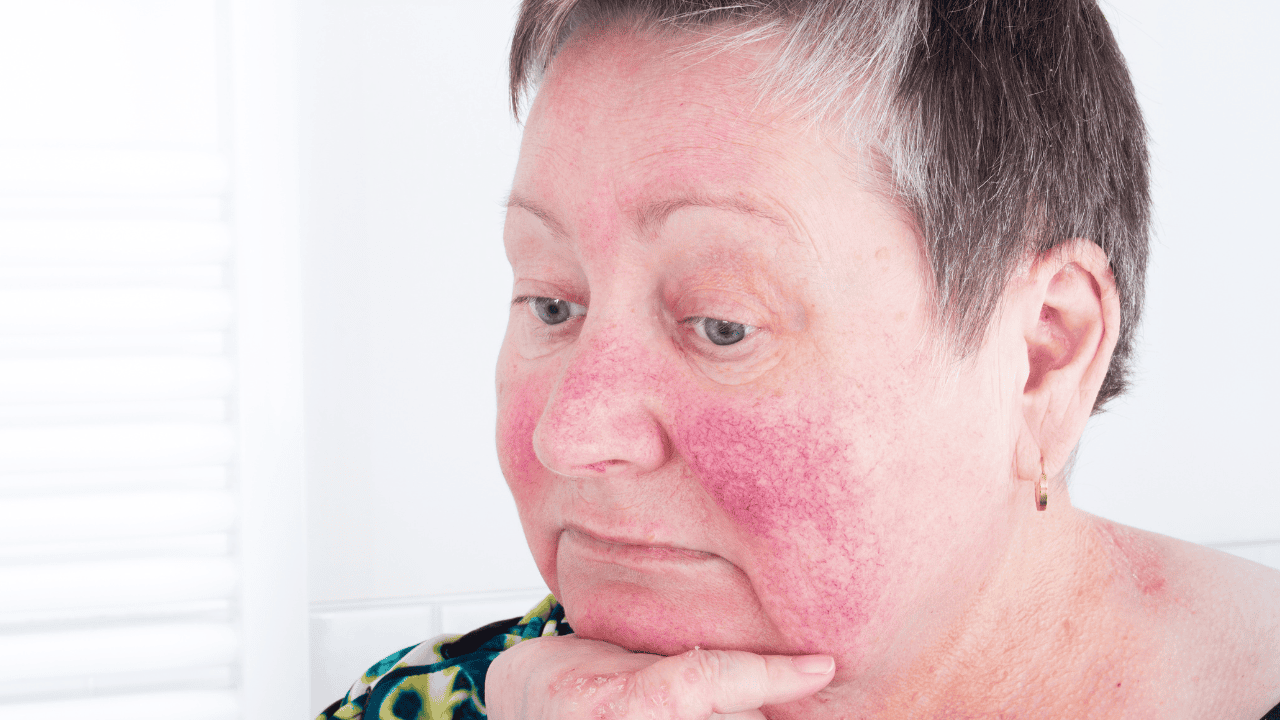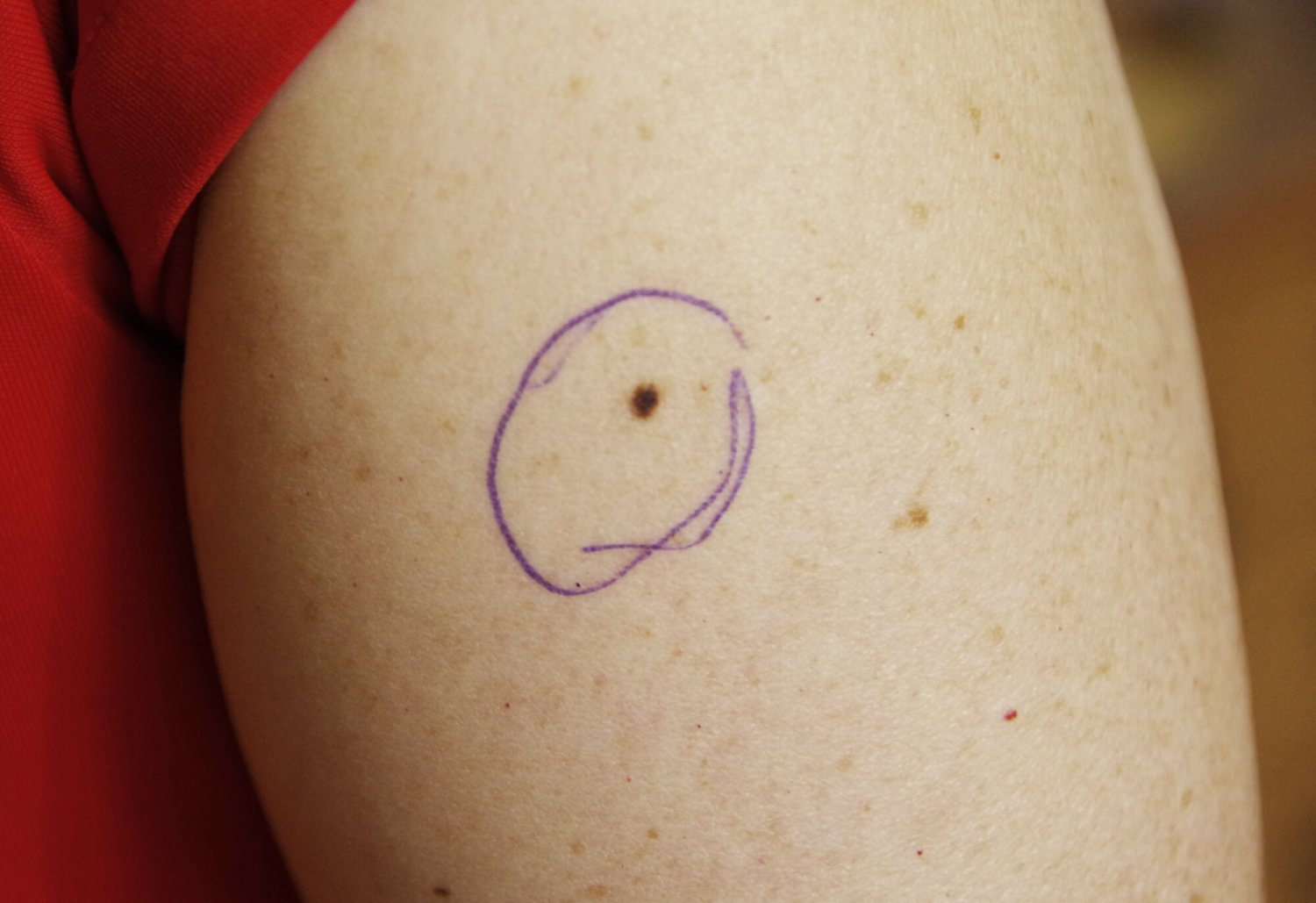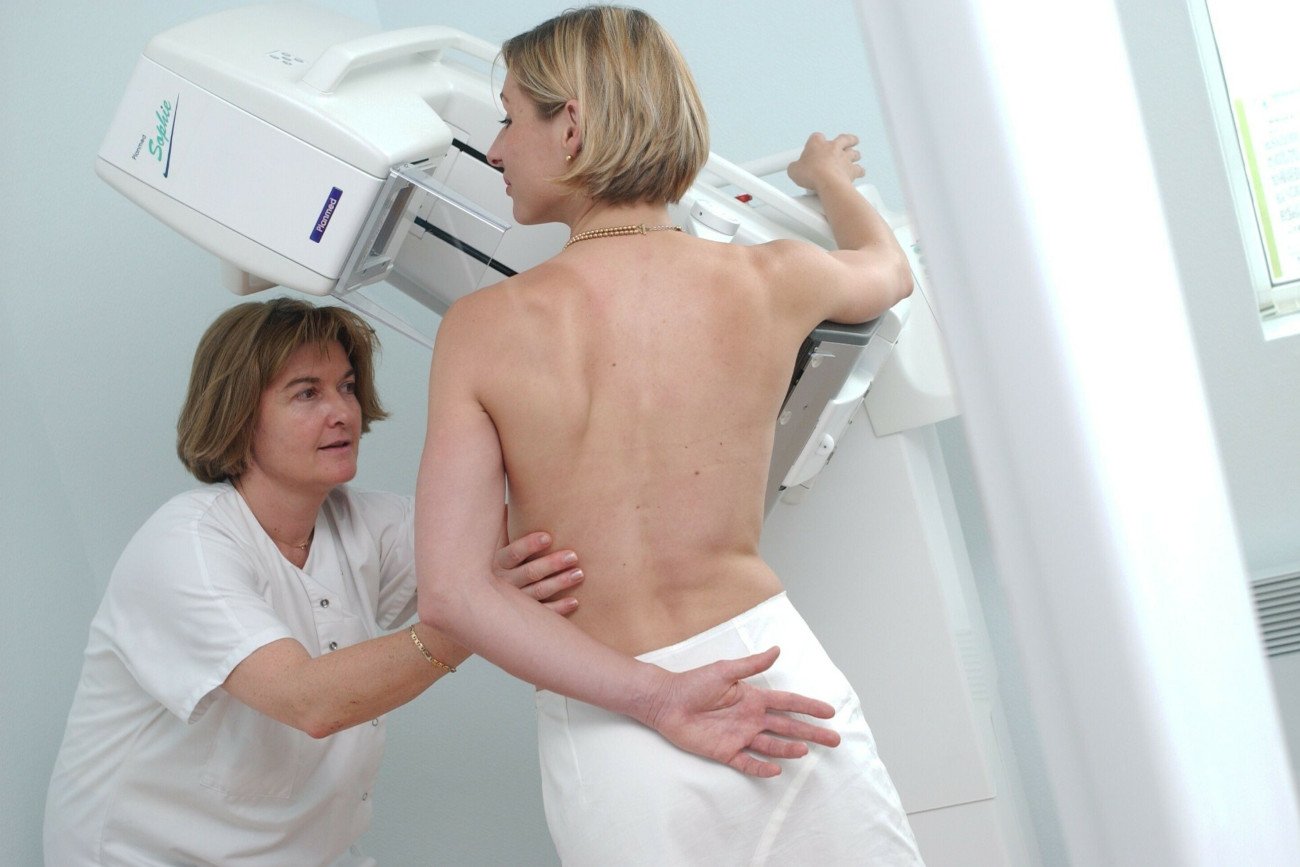Mark Flores sits at the kitchen table drawing birthday cakes. At 44, he loves to draw circles, a skill he’s mastered over the past decade of his life. His thick black hair is neatly combed like the Superman cartoon on his T-shirt. Grasping thick Crayola markers, he lines up tiny circles in rows within larger oblong shapes. Mark has accomplished much more than his mother, Yvette, was told he always could erstwhile he was born — erstwhile doctors said he wouldn’t be able to interact with people due to his intellectual disabilities.
Instead, Mark greets most people with a big, toothy smile, stoops over to give them a hug if they’re willing, and is fast to answer most questions with an enthusiastic “yeah.”
When Mark coughs at the table, Yvette asks him if he needs water. “You don’t have to, Mark, you can say no,” she says, her soft brown eyes behind black cat-eye glasses. “We’re learning ‘no,’” she says to me as an aside. Like her son, she’s fast to flash a smile. Her dark hair falls loosely around her shoulders, streaked with silver against her face.
Yvette was working at a mill in the early days of Silicon Valley erstwhile she got pregnant with Mark. An employment center placed her there in 1975. She was 18 and had late gotten her GED. She just needed a job, she says. Today, she is 1 of hundreds of erstwhile Silicon Valley workers who say they unknowingly handled harmful substances on the occupation and later filed suit against their employers.
Manufacturing semiconductors, the chips needed for all our consumer electronics today, was reshaping Yvette’s community. The manufacture employed many women and young people from Hispanic and Asian immigrant families who’d previously worked in canneries that were closing up store as Americans started importing more fresh fruit. The factories offered a fresh kind of assembly line work that you didn’t request a degree or much training to land.
But a deficiency of appropriate safety measures left workers susceptible to a slurry of chemicals that posed dire wellness risks. Over the years, many of the workers had miscarriages, including Yvette. any gave birth to children with disabilities; Mark was 1 of those kids.
Yvette has painstakingly built a safe haven for Mark in their home filled with toys and vacation decorations year-round. An inflatable Santa greets guests in the surviving room, even though it’s March erstwhile I visit. There’s a giant heart-shaped balloon from Valentine’s Day, deflating but inactive floating above Mark’s head. Plush Chuck E. Cheese characters are seated around their home, dressed up in old clothes complete with mismatched shoes peeking out below too-big pants. Mark’s drawings are tucked below many of the stuffed animals.
The Verge sought out legal papers and old media reports to find Mark and any of his peers — a generation of kids, now adults, whose parents say they paid the price for lax workplace standards in an manufacture that uses an ever-evolving cocktail of chemicals to make computer chips.
For any time, miscarriages associated with the chip manufacturing manufacture were well documented in investigation papers. The risks discovered by scientists prompted companies to pledge to halt utilizing certain chemicals — at least in the United States. After that, though, the manufacture did an about-face on transparency with researchers. As personnel data dried up, it became harder to show adverse reproductive wellness outcomes among employees on paper, even as many parents said their kids were surviving with the consequences.
US-based investigation into these wellness risks slowed down as semiconductor manufacturing moved to Asia in the 1980s. But with the fresh push to revive chip manufacturing in the US, these concerns are bubbling back up to the surface. In fresh years, as diplomatic relations with China have deteriorated, and with the AI arms race continuing to accelerate, the Biden administration poured billions of dollars into subsidizing a home chip industry. Now, unions and wellness and environmental advocates are one more time fighting to defend workers to make certain that Silicon Valley’s toxic past doesn’t repeat itself.
“Now looking back I mean, it just gets me so so upset. I realize they gotta make money,” Yvette tells The Verge, “but not at the cost of another person.”
Like many of her colleagues in the early days of Silicon Valley, Yvette didn’t know what kinds of risks were posed by the substances she was handling. In any manufacturing facilities — called fabs — workers donned masks and head-to-toe smocks called “bunny suits” before entering “clean rooms.” Those protective measures weren’t meant to shield workers from the industrial solvents, adhesives, and another chemicals in the room; they were for the chips, which were so delicate they needed to be shielded from airborne microbes.
Nothing had been designed to defend the people making them.
By the mid-1980s, there was expanding talk of miscarriages among fab workers, the majority of whom were women. No link had yet been established between semiconductor chip manufacturing and miscarriages; possibly for that reason, companies freely cooperated with academic researchers, assured that they would yet dispel concerns about working conditions. But the series of studies that followed would scope grave conclusions.
Scientists at the University of Massachusetts Amherst surveyed a tiny group of workers at a single fab in Massachusetts. Then, the University of California, Davis launched a larger survey from a example of about 50,000 employees at 14 different semiconductor companies representing around a 5th of semiconductor workers in the US at the time. IBM, believing it took more precautions than its peers, decided to fund its own separate survey with researchers from Johns Hopkins University.
Ultimately, these three separate industry-backed studies found higher than expected rates of miscarriages among women who worked on semiconductor production lines — as much as twice as advanced as those who didn’t work there.
The large survey by University of California researchers was published in the American diary of Industrial Medicine in 1995. The authors first conducted a historical analysis by interviewing workers who had gotten pregnant while working for a semiconductor company between 1986 and 1989. They found a 43 percent higher hazard of miscarriage among women who worked in chip fabrication rooms compared to employees in another departments (often office workers) without the same vulnerability to chemicals.
Researchers besides carried out a second analysis of current employees, conducting interviews and collecting urine samples to monitor pregnancies and miscarriages. In that cohort, they found a 25 percent increase in miscarriage hazard among those who worked in fab rooms. The figures were adjusted for age, ethnicity, and another possibly confounding factors like whether each individual smoked cigarettes. A majority of the miscarriages in that cohort were subclinical, meaning the female didn’t know about the pregnancy before losing it.
“The bottom line is that both studies showed a tiny but crucial hazard of increased miscarriage associated with fabrication work,” says Marc Schenker, a coauthor of that investigation and a distinguished prof. emeritus of public wellness sciences and medicine at the UC Davis School of Medicine.
The highest hazard for miscarriage was among women who worked with certain ethylene glycol ethers (EGEs) utilized in photoresist chemicals that coat semiconductors, which the manufacture subsequently pledged to phase out in the 1990s.
“The single biggest takeaway from my point of view, is that low concentrations, what we think of as secure concentrations, can actually have a serious impact and reproductive effects,” says Katharine Hammond, an associate dean at the University of California, Berkeley’s postgraduate School of Public wellness and another 1 of the authors of the industry-backed miscarriage research.
And EGEs are just 1 group of chemicals in a constantly evolving mix — not only in semiconductor clean rooms, but in manufacturing facilities across the supply chain for computer chips. A 1999 article in the diary Environmental wellness Perspectives names 10 “chemicals of concern in the semiconductor industry” that include known carcinogens and another substances tied to reproductive wellness problems, including lead and arsenic. IBM alone faced any 250 lawsuits filed by employees who developed cancer, suffered miscarriages, or whose children were born with intellectual disabilities or birth defects.
Semiconductor manufacturing was beginning to decision to Asia more steadily by the ’90s, with a majority located in South Korea, Taiwan, Japan, and China by the 2010s. Since then, it’s been harder to suss out the possible reproductive wellness risks workers face. Many in Asia were inactive exposed to EGEs through at least 2015, a Bloomberg investigation found.
But later studies on workers’ reproductive wellness have been a mixed bag. 1 study in South Korea in 2015 attempted to estimation miscarriages utilizing claim data from the National wellness Insurance. Looking at instances of women who sought healthcare for a miscarriage, the researchers found higher rates among microelectronics workers compared to control groups of bank employees, the larger working population, and “economically inactive women.” The authors besides said, however, that more studies “based on primary data collection and careful surveillance are required to confirm these results.”
In 2017, a separate study relying on questionnaires from workers at 2 semiconductor manufacturing plants in South Korea didn’t find a statistically crucial difference in miscarriages among workers on the production level compared to clerical workers. Workers in 1 production area, however, showed higher hazard prior to 2008. That suggested that changes in working conditions, like more automation, might have reduced risk. A 2019 review of prior English-language investigation on semiconductor work and miscarriage subsequently confirmed a statistically crucial association between fab work and miscarriage from early investigation through the mid-1990s, but “due to the deficiency of studies … could not measure spontaneous abortion hazard based on current working environment.”
There are limitations to each of these studies that make it hard to find what the reproductive wellness risks are for semiconductor workers today. But there are more clear outcomes from investigation conducted on miscarriages in the early days of Silicon Valley, erstwhile companies were open to sharing worker data. A generation of workers unknowingly handled hazardous substances on the occupation without adequate protections and paid the price.
At the kitchen table, Yvette borrows 1 of her son’s markers to illustrate the occupation she had erstwhile she was pregnant with him.
Between 1975 and 1980, she worked on an assembly line in Santa Clara County, California, for Spectra-Physics, a company that billed itself as a leading supplier of lasers for semiconductor manufacturing. Lasers would, for instance, be utilized to cut individual chips from larger silicon wafers.
But first, workers like Yvette would gotta put those lasers together. With a bubblegum pink marker, she draws a long cylindrical form with an angled edge. Her occupation was gluing a slanted glass bevel to a tube, then hitting the joint with a blowtorch to cure it.
She wore a mask, 1 thin adequate that she could inactive odor through it as she stirred and sprayed the green adhesive they called frit. She’d dump any unused chemicals down the sink in the tiny area she shared with 1 another individual cooking beryllium in an oven behind her. She could feel the blast of heat each time he opened the oven door.
“There was so much going on there,” Yvette recalls. “I had to walk out of there quite a few times due to the fact that it got so stuffy.”
One day at work in 1978, Yvette began bleeding in the restroom of Spectra-Physics. The experience is mostly a blur to her today, but there are things she inactive distinctly remembers — the intense, painful cramping; another female inside the restroom telling her she should go to the hospital; and finally, a doctor at the infirmary telling her that she had had a miscarriage.
It’s inactive hard for Yvette to talk about what happened. Her voice falls to a quiet monotone as she tells this part of her story. She went back to work after what happened in the bathroom, inactive unaware of what risks she faced on the job. She didn’t fishy at the time that anything in her workplace could have led to the miscarriage. In 1979, erstwhile she was 22, she got pregnant with Mark. She kept working at Spectra-Physics until Mark was born with a severe intellectual disability, erstwhile she left her occupation to become his primary caregiver.
She’s a tenacious advocate for her son. erstwhile he graduated from a peculiar education school at 23, she borrowed a cap and gown from a photography studio so that he could attend the celebration in the conventional garb, even though it wasn’t part of the ceremony.
“I wanted him to experience the cap and gown, which he did,” she says. The tassel was “a real beautiful blue.”
Things got harder after Mark’s father died in a motorcycle accident in 2007 at the age of 48 — not much older than Mark is now. He had problem knowing what happened, why his dad wasn’t around anymore. He acted out, sometimes flipping chairs over or abruptly grabbing people. Yvette struggled at first to find aid for her son, looking for therapy and day care programs that would take him. “I tried calling out, ‘help me,’ you know, to quite a few agencies,” she says. “I’m not the only 1 who can have this happen to you.”
It wasn’t until she heard an ad on the radio a couple of years later that she started to realize how many another people might be facing something similar. The ad was from a law firm trying to scope erstwhile electronics manufacture workers who had children with birth defects.
“I kept proceeding it,” she says. “And I’m going, that sounds like everything that’s happened to me … it was checkmarks in my head going yup, yup,” she says substance of factly.
Yvette called the number from the ad and filed suit against Spectra-Physics in 2010. During the discovery process, another worker came forward to share a document revealing what was in the green “frit” Yvette handled each day at work: the biggest ingredient was lead.
Lead dust likes to travel. It’ll all besides readily stick to skin and clothes, following a individual all the way home after work. It doesn’t easy wash distant with regular soap — there are peculiar deleading soaps for a reason. If a pregnant individual breathes or ingests lead, it can decision through the placenta into a developing fetus. In fact, the fetus is likely to have the same level of lead in its blood as the adult carrying it.
“It’s a very potent developmental hazard, so it very much harms a developing brain,” says Carissa Rocheleau, PhD, a reproductive occupational epidemiologist in the National Institute for Occupational Safety and wellness Division of Field Studies and Engineering.
That could have a wide scope of effects, Rocheleau says, possibly impacting behavior, cognitive abilities, motor skills, and speech. investigation has besides linked advanced levels of lead in the blood to increased hazard of miscarriage.
The impact lead has on the body is well understood — surely much better understood comparative to the many another substances found in semiconductor fabs that usage an ever-changing cocktail of chemicals. What many of these substances can do to fetal improvement is an open question.
LeAnn Severson got a occupation at a semiconductor plant for Electronic Arrays in Mountain View, California, the same year Mark was born. She worked the evening swing shift sorting wafers — the large silicon discs from which individual computer chips are cut. She met her soon-to-be husband Keith on the job; he was a wafer sorter, too.
During each shift, they placed wafers under a microscope for a device to test for defective chips. If it spotted one, it would mark the chip with a dot of red ink. To be truly sure, the device would request to test it again. So wafer sorters like the Seversons would take the possibly defective disk, wash the ink off with a solvent in a sink, and then place the wafer back under the microscope.
LeAnn remembers squirting solvent onto the wafers utilizing plastic bottles with bent straws. erstwhile the squirt bottles ran empty, they would refill them from large brown bottles sitting on the floor. The bottles were labeled methyl ethyl ketone (MEK), a name that was hard for her to forget.
“Back in the ’60s, my dad would always talk about filling the car with ethyl gasoline or something like that. And this kind of stuck in my head, the methyl ethyl, it kind of rhymes. And so I remembered it,” she says. She didn’t think the chemical was any harsher than nail polish remover; MEK has a sickly sweet odor akin to acetone.
Gloves were optional on the job, LeAnn says. “If you were wearing fingernail polish, it would come off. We would just proceed to get a paper towel and take off the remainder of our polish, you know, with that same solution due to the fact that it smelled like fingernail polish remover. No 1 told us not to.”
There’s been limited investigation on what constant vulnerability to MEK does to the body — it’s not the kind of thing that can be easy studied in humans. It’s been linked to developmental effects in fetuses in studies with mice and rats. But results from animal studies frequently don’t hold actual for humans, especially erstwhile it comes to reproductive outcomes. A suite of another industrial solvents and chemical products were utilized on the job, according to the suit LeAnn Severson filed against her erstwhile employer — any of those could have affected her body as well.
The Severson’s son, Darryl, was born in 1980 with microcephaly, a condition in which a baby is born with a smaller head than usual. Today, he loves watching Sesame Street and going to the library to choice out books with his mom. He reads at about a fifth-grade level. “He’s an adult child,” LeAnn says.
LeAnn didn’t draw the connection between Darryl’s condition and the chemicals she worked with until the late ’80s, erstwhile she saw a PBS news peculiar on birth defects in Silicon Valley. She wrote a handwritten letter to the state’s wellness department, which she says subsequently referred her to the same occupational wellness lawyer that represented Yvette.
Both women settled out of court with their employers, which helped each of them care for their sons full time. IBM besides reached settlements in at least 2 closely watched suits filed by another parents who worked at its semiconductor plant in East Fishkill, fresh York. 1 kid was born with microcephaly. Another was born with a uncommon disorder called Hallermann-Streiff syndrome that causes face and skull malformations. IBM avoided what likely would have been high-profile trials by settling, and denied wrongdoing.
“I mean, everybody trusts their workplace,” she says. “They think they’re going to be safe erstwhile they walk in.”
Amanda Hawes has represented people who gave birth to children with intellectual disabilities or birth defects after working in California’s early electronics manufacture since the 1970s. Hawes moved to San Jose, California, before it was known as the heart of Silicon Valley. Back then, it was called the “Valley of Heart’s Delight” due to its orchards lush with peaches and plums — fruit that was utilized in the region’s many canneries. (Yvette Flores inactive remembers her mom coming home from her cannery occupation late at night, smelling of peaches.)
Hawes started off representing cannery workers fighting for lost wages. As the tech manufacture started to crowd out agriculture, many of the same employees started working for semiconductor fabs alternatively of canneries — and coming to Hawes with fresh wellness issues they traced back to chemicals at work. Hawes and another advocates have spent decades trying to figure out just how many people have been affected. It’s a hidden epidemic, she believes, in part due to the fact that semiconductor companies stopped cooperating with outside researchers after those early studies into miscarriages.
In 1997, California’s Department of wellness Services crafted a proposal to make a database to survey birth defects, cancer rates, and deaths among electronics workers. The state had been collecting data from birth certificates in the San Francisco area since 1983 through its Birth Defects Monitoring Program. They already had names and birth information; they just needed occupation titles from employers to survey whether there were any links between birth defects in children and their parents’ occupations. The initiative even garnered a $100,000 backing commitment from the Environmental Protection Agency, The Wall Street Journal reported the following year.
This time around, manufacture leaders decided it wasn’t a good thought to participate. “I might as well take a weapon and shoot myself,” Intel’s manager of environmental affairs at the time reportedly said during a January 1998 EPA gathering where the proposal was yet blocked. Agreeing to share personnel records for the survey “would be like giving discovery to plaintiffs’ lawyers,” The Wall Street Journal reported him saying.
Even if the chip manufacture had cooperated, there was a reasonably large hurdle, just from a purely academic perspective. Ascertaining any connections between birth defects and toxins at work would have been a much taller order than linking miscarriages and toxins. Defects affect around 3 percent of births in the US, while about 20 percent of pregnancies end in miscarriage. due to the fact that birth defects are uncommon, studies would request to include a larger pool of people. The California Department of wellness Services proposal hoped to gather data from at least 100,000 workers for its proposed database, compared to the large UC Davis survey on miscarriages based on around half that number of employees.
There are besides many different kinds of birth defects that may each warrant their own study. “Something can be a hazard origin for breast cancer, but not tummy cancer, right? And the same is actual with birth defects,” says Rocheleau. In another words, different triggers can lead to different kinds of wellness outcomes, whether that’s varying types of cancer or birth defects.
Many factors throughout each phase of fetal improvement and even before pregnancy might lead to a birth defect. Does a chemical harm DNA or alter the physical improvement of a fetus? And if so, where and how? Which parent was exposed to the chemical, and what impact does that have?
Miscarriages themselves besides complicate investigation into birth defects. The fetus has to last long adequate to be diagnosed, and the most severe birth defects might end with a miscarriage, according to Rocheleau. In that sense, you can think of birth defects and miscarriages as different points along the same spectrum of possible outcomes from chemical exposure. any pregnancies might end. Others could come to full term, even though the fetus is susceptible to the effects of that chemical.
“Sometimes people tend to think of the placenta as being a barrier, but that’s truly not actual for quite a few tiny molecules, like most chemicals are,” Rocheleau says. “It’s possibly more accurate to think of it as an expressway for nutrient transportation and it can deliver toxicants to the fetus as well.”
A fetus doesn’t have all of its defence systems up yet; its organs are inactive a work in progress. A single cell in a fetus may be destined to become an full organ strategy — and harm to that cell, of course, could have widespread effects on the improvement of that system. The liver, which filters out toxins, isn’t histologically complete until 2 weeks before birth. And the toxin doesn’t even request to scope the fetus to affect it — there are a number of indirect risks to a fetus simply due to the fact that its parent is sick. If a toxic substance triggers wellness issues in the full grown adult who is carrying it, the adult’s wellness issues can have additional effects on fetal development.
That’s all to say, it’s complicated. A pair of studies on birth defects among semiconductor workers in Taiwan published in 2007 and 2008 besides found diverging outcomes based on sex. The researchers found a heightened hazard of death from birth defects among the children of male workers. They didn’t see the same elevated hazard in female workers, nevertheless — they alternatively documented an increased hazard of cancer among the children of female workers.
From the front seats of their car, Amanda Hawes and her husband, Ted Smith, survey the campus of nondescript office buildings and vacant parking spaces. While Hawes represented workers, Smith started the nonprofit Silicon Valley Toxics Coalition in the 1980s with another residents afraid about chemicals leaching into the dirt and groundwater.
“It’s a ghost town,” Smith says. It’s all empty now, following a wave of layoffs in Silicon Valley over the past year. In the parking lot, Ted is looking for a site where he remembers an old carbon treatment strategy moving to clean up contaminated water. Now, it’s just a suburban landscape.
Much of it, however, sits atop land so contaminated that it was placed on a national precedence list for cleanup. They’re called Superfund sites, and Santa Clara has more of them than any another region in the US. It’s a legacy of the early days of Silicon Valley, erstwhile companies simply flushed chemicals down sinks or stored them in leaking underground tanks.
Across the US, fresh fights are starting to crop up in communities close fresh semiconductor manufacturing sites. Now in their 70s, the couple is an integral part of CHIPS Communities United, a national coalition that’s backed by Sierra Club, the Communications Workers of America union, and another labour groups.
The rush to make more powerful chips for AI is raising the stakes. But without stronger protections for workers, says Hawes. “We’re getting ready to repeat the same stuff.”
The 2021 CHIPS and discipline Act, spearheaded by the Biden administration, set aside $52.7 billion in backing for home semiconductor manufacturing. That included $200 million specifically for semiconductor workforce development. The administration launched 2 semiconductor “workforce hubs” in the last 2 years in Ohio and Arizona. In Ohio, community colleges are working with Intel to make curriculums for semiconductor technician roles. In Arizona, Intel, TSMC, and NXP Semiconductors announced fresh apprenticeship programs with support from state and local governments. And in April, the Biden administration announced a 3rd workforce hub in upstate fresh York. The Biden administration said that its incentives attracted nearly $450 billion more in private investments for semiconductors and electronics manufacturing. All in all, it’s expected to make more than 145,000 jobs in construction and manufacturing if the subsidies last the current Trump administration.
More than $30 billion of CHIPS Act backing has already been doled out to companies building fresh factories across the US. Meanwhile, health, safety, and environmental concerns have started to crop up with any projects. A truck driver died in an explosion in May, reportedly while transporting a pressurized tank of sulfuric acid at a site where TSMC is building a fresh manufacturing facility.
The CHIPS Communities United coalition wants more transparency around what kinds of chemicals semiconductor manufacturers are utilizing in the next generation of fabs. Last summer, the group asked the Department of Commerce to conduct more thorough environmental reviews of at least 3 federally funded projects to build or grow fabs. That included TSMC and Intel’s plans in Arizona and a Micron task in Idaho. The draft assessments didn’t include adequate information on what kinds of substances workers might be exposed to or adequate details on what protections would be in place, they contend in comments they submitted to the Commerce Department and shared with The Verge.
TSMC didn’t respond to requests for comment. Intel didn’t comment on the Arizona facility. With respect to the industry’s historical usage of hazardous chemicals and comments that Intel’s manager of environmental affairs reportedly made in 1998, spokesperson Patricia Oliverio said in an emailed message that “the wellness and safety of our workforce is our top priority. Intel uses advanced engineering controls and best practices based on regulatory and manufacture standards to defend our workforce.”
In October 2023, CHIPS Communities United published a letter to semiconductor manufacture execs asking them to sign legally binding community benefit agreements erstwhile they build fresh fabs. They asked companies to replace chemicals that can origin cancer, miscarriages, birth defects, and fetal brain damage. The letter urged companies to be more proactive, alternatively than simply following the Occupational Safety and wellness Administration’s vulnerability limits for chemicals — most of which haven’t been updated since the 1970s after years of industry pushback and Republican efforts to kneecap OSHA.
The agency itself says its vulnerability limits “are outdated and inadequate for ensuring protection of individual health” and recommends that employers adhere to more fresh guidelines developed by the state of California, the NIOSH, and the nonprofit American Conference of Governmental Industrial Hygienists.
Semiconductor manufacturers say that they’ve limited the vulnerability of workers to different chemicals, in part by automating much more of the manufacturing process.
“Just as chips themselves have improved dramatically over the last respective decades, so besides has semiconductor individual wellness and safety, thanks to advancements in fabrication techniques and automation, the adoption of enhanced safety standards and engineering controls, and improvements in the quality of individual protective equipment,” Dan Rosso, vice president of communications at the Semiconductor manufacture Association, said in a message to The Verge.
Even so, wellness and labour advocates stay worried. “It inactive takes people to actually make these things run even though they’re highly automated,” says Ted Smith. “And so there inactive is the chance for vulnerability — and it’s never to 1 chemical, it’s mixtures of chemicals.”
The chemical cocktail is constantly changing in workplaces, and frequently at a faster rate than scientists can survey the possible risks at play. On top of that, companies are frequently reluctant to share what chemicals they’re using, protecting them as trade secrets. The semiconductor industry’s reassurances are, simply, hard to verify.
In the meantime, Silicon Valley, where it all started, is inactive cleaning up the mess left behind by the first generation of semiconductor fabs.
The place where Yvette Flores worked erstwhile she got pregnant with Mark is besides a Superfund site. But unlike the cluster of empty office buildings in Santa Clara County, this site is buzzing with activity on Sundays. alternatively of a laser manufacturing plant, there’s a church that serves a primarily Korean American community, complete with a colorful playground and basketball court in the back. Picnic tables and lawn chairs sit on Astroturf behind a white picket barrier labeled the “seniors’ lounge.” The church’s website advertises a Sunday school program named Love Land for “our littlest ones” and Joy Land for toddlers to kindergarteners.
“Thousands of pounds” of volatile organic compounds have been removed from the groundwater and dirt at this Superfund site over the past 3 decades, according to the EPA’s website. More assessments are needed to find whether the anticipation of vapors rising from lingering contaminants into indoor spaces is inactive a concern, it says. Part of the ongoing cleanup plan, as stated by the EPA, is to prevent homes and schools from being built there. Neither the EPA nor church leadership answered questions from The Verge about why the church was located there.
MKS Instruments, which owns the brand Spectra-Physics now, said in an email that “Spectra-Physics no longer exists as a legal entity, and we have not owned or leased any of the properties that comprise the superfund site since 2010. We cooperate closely with EPA and the San Francisco Regional Water Quality Control Board on the ongoing site cleanup measures.”
Yvette learned about the church on the site for the first time erstwhile I mentioned it to her. She was alarmed — an hr later, she tells me that it’s inactive bothering her.
We’re back at her kitchen table after taking Mark to eat any pizza. The thought of the church — the Sunday school, the playground — is lingering in her mind.
“That’s so sad,” she says, drawing out the word sad into 2 syllables.
She’s shortly distracted by cats that have wandered into the backyard, part of a menagerie of animals in the vicinity that she and Mark watch through the sliding glass door across from the kitchen each day.
“As long as I have breath, me and you, huh?” Yvette says, standing up from the table to give her boy a hug.
“Me and you,” Mark says.

















